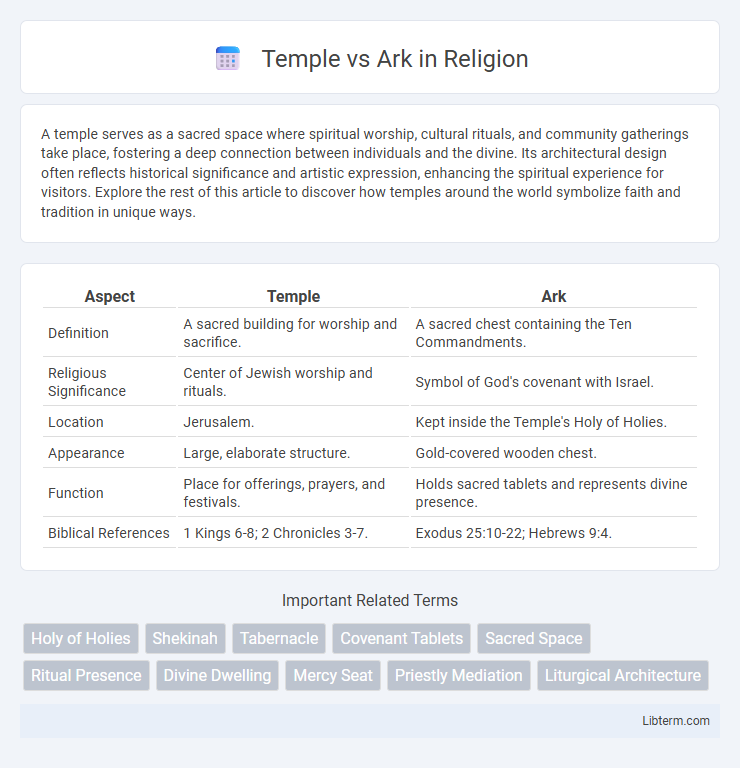A temple serves as a sacred space where spiritual worship, cultural rituals, and community gatherings take place, fostering a deep connection between individuals and the divine. Its architectural design often reflects historical significance and artistic expression, enhancing the spiritual experience for visitors. Explore the rest of this article to discover how temples around the world symbolize faith and tradition in unique ways.
Table of Comparison
| Aspect | Temple | Ark |
|---|---|---|
| Definition | A sacred building for worship and sacrifice. | A sacred chest containing the Ten Commandments. |
| Religious Significance | Center of Jewish worship and rituals. | Symbol of God's covenant with Israel. |
| Location | Jerusalem. | Kept inside the Temple's Holy of Holies. |
| Appearance | Large, elaborate structure. | Gold-covered wooden chest. |
| Function | Place for offerings, prayers, and festivals. | Holds sacred tablets and represents divine presence. |
| Biblical References | 1 Kings 6-8; 2 Chronicles 3-7. | Exodus 25:10-22; Hebrews 9:4. |
Understanding the Temple: Definition and Significance
The Temple, a sacred structure in ancient Israel, served as the central place of worship and housed the Holy of Holies, where the Ark of the Covenant was kept, symbolizing God's presence. It held immense religious significance as the site for sacrifices, prayers, and festivals, reflecting God's covenant with His people. The Temple's architectural grandeur and spiritual functions underscored its role as a unifying center for Jewish identity and religious practice.
The Ark of the Covenant: Origins and Meaning
The Ark of the Covenant, described in the Hebrew Bible, is a sacred chest built by the Israelites under Moses' instruction to hold the stone tablets of the Ten Commandments. This ancient artifact symbolizes God's covenant with the Israelites and was central to their worship, representing divine presence and guidance. Unlike the temple, which served as a permanent dwelling place for God, the Ark was a portable sanctuary used during the Israelites' journey through the desert.
Temple vs Ark: Key Differences
The Temple and the Ark differ primarily in purpose and symbolism: the Ark of the Covenant served as a sacred chest housing the stone tablets of the Ten Commandments and represented God's covenant with Israel, while the Temple functioned as the central place of worship and sacrifice for the Israelites. Architecturally, the Ark was a portable, gold-covered wooden chest, whereas the Temple was a massive, stationary complex in Jerusalem designed to house the Ark and facilitate religious ceremonies. The Ark symbolized God's presence among His people during their wanderings, whereas the Temple symbolized a permanent dwelling place for worship and divine presence on Zion.
Historical Context: Temple and Ark in Ancient Israel
The Temple in Ancient Israel, primarily Solomon's Temple built in the 10th century BCE, served as the central place of worship and housed the Ark of the Covenant, a sacred chest containing the tablets of the Ten Commandments. The Ark symbolized God's covenant with Israel and was considered the earthly throne of God, playing a crucial role during the Israelites' desert wanderings and early settlement period. While the Ark was a portable sacred object, the Temple represented a permanent structure signifying Israel's religious and national identity during the united and later divided monarchy eras.
Theological Symbolism of the Temple
The Temple in biblical theology symbolizes God's tangible presence among His people, representing divine holiness, worship, and covenantal relationship. It serves as the epicenter for sacrificial rites and festivals, illustrating God's provision for atonement and communion with humanity. This sacred space contrasts with the Ark, which primarily signifies God's covenantal promise and divine protection.
Spiritual Significance of the Ark
The Ark of the Covenant holds profound spiritual significance as the divine presence of God manifested among the Israelites, symbolizing a covenantal relationship and God's guidance. It housed the stone tablets of the Ten Commandments, signifying God's law and moral authority, and represented a tangible connection between heaven and earth. This sacred vessel served as a focal point for worship, divine communication, and the Israelites' identity as God's chosen people.
The Temple and the Ark in Religious Practice
The Temple served as the central place of worship in ancient Israel, housing the Holy of Holies where the Ark of the Covenant was kept, symbolizing God's presence. The Ark, an ornate wooden chest covered in gold, contained the stone tablets of the Ten Commandments and was central to religious rituals and divine communication. Together, the Temple and the Ark played a pivotal role in maintaining the covenant between God and the Israelites, anchoring religious practice and communal identity.
The Loss and Legacy of the Ark
The Ark of the Covenant, central to ancient Israelite worship, was lost during the Babylonian conquest of Jerusalem around 586 BCE, leaving a profound religious and cultural void. Its disappearance symbolizes the end of an era where the Ark represented God's tangible presence, shifting focus to the Temple as the new sacred locus of worship. Despite its loss, the Ark's legacy endures through biblical narratives, influencing Jewish, Christian, and Islamic traditions as a powerful emblem of divine covenant and spiritual authority.
Modern Interpretations: Temple and Ark Today
Modern interpretations of the Temple emphasize its role as a symbol of spiritual connection and communal identity, often inspiring contemporary architectural designs and interfaith dialogues. The Ark is viewed today not only as a sacred container but also as a powerful metaphor for protection, hope, and the preservation of cultural heritage. Both the Temple and the Ark continue to influence religious practices, artistic expressions, and the collective memory of Jewish and wider communities worldwide.
Conclusion: Lasting Influence of Temple and Ark
The Temple and Ark each symbolize profound spiritual authority and cultural identity, shaping religious practices across centuries. The Temple's architectural grandeur and ritual significance established a central place of worship influencing Jewish traditions and Christian theology. The Ark, embodying divine presence and covenant, continues to inspire faith narratives and serves as a powerful emblem of sacred trust and divine protection.
Temple Infographic

 libterm.com
libterm.com